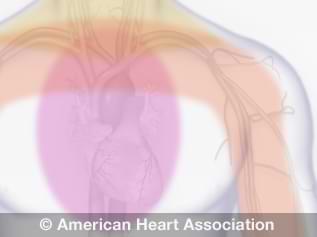What Causes Upper Chest Pain and Goes Thru to Your Back

Angina is chest pain or discomfort caused when your heart muscle doesn't get enough oxygen-rich blood. It may feel like pressure or squeezing in your chest. The discomfort also can occur in your shoulders, arms, neck, jaw, abdomen or back. Angina pain may even feel like indigestion. In addition, some people don't feel any pain but have other symptoms like shortness of breath or fatigue. If these symptoms are due to a lack of oxygen to the heart muscle, it's called an "anginal equivalent."
But angina is not a disease. It's a symptom of an underlying heart problem, usually coronary heart disease (CHD), also known as coronary artery disease (CAD).There are many types of angina, including stable, unstable, microvascular, and angina caused by a spasm in the coronary arteries (vasospastic or variant). View an animation of angina(link opens in new window) (link opens in new window).
Angina usually happens because one or more of the coronary arteries is narrowed or blocked, also called ischemia.
Angina can also be a symptom of coronary microvascular disease (MVD). This is heart disease that affects the heart's smallest coronary arteries and is more likely to affect women than men. Learn more about angina in women.
Depending on the type of angina you have, there are many factors that can trigger angina pain. The symptoms also vary based on the type of angina you have.
Types of Angina
Knowing the types of angina and how they differ is important.
- Stable angina
- Unstable angina
- Microvascular Angina
- Vasospastic or variant angina
Understand Your Risk for Angina
If you're at risk for heart disease or coronary artery disease, you're also at risk for angina. The major risk factors for heart disease and coronary artery disease include:
- Unhealthy cholesterol levels
- High blood pressure
- Smoking
- Diabetes
- Overweight or obesity
- Metabolic syndrome
- Physical inactivity
- Unhealthy diet
- Older age (The risk increases for men after 45 years of age and for women after 55 years of age.)
- Family history of early heart disease
Diagnosis
All chest pain should be checked out by a health care professional. He or she will want to find out if it's angina and if it is, whether the angina is stable or unstable. If it's unstable, you may need emergency medical treatment to try to prevent a heart attack.
Your health care professional will most likely perform a physical exam, ask about your symptoms, and ask about your risk factors for and your family history of heart disease and other cardiovascular conditions.
Your health care professional will also ask you a series of questions to rule out the most critical or life-threatening possibilities. Think ahead so you can provide as much information as possible. Here are some questions you might be asked:
- How long have you had this condition?
- On a scale of 1 (mild) to 10 (critical), what is your level of discomfort?
- What behavior(s) provoke the pain? Physical activity? Eating?
- What relieves the discomfort?
Print our Angina Log to keep track of your angina symptoms.
Angina Treatment
If your health care professional thinks that you have unstable angina or that your angina is related to a serious heart condition, they may recommend the following tests and procedures:
- EKG (Electrocardiogram)
- Stress Test
- Blood Tests
- Chest X-rays
- Coronary Angiography
- Cardiac Catheterization
- Computed Tomography Angiography
Treatment of angina includes:
- Determining the cause
- Cardiac procedures to open blocked arteries
- Medicines to help keep the arteries open
- Medicines to treat other medical conditions and risk factors like high blood pressure, high cholesterol and diabetes
- Lifestyle changes including healthy diet and physical activity
- Cardiac rehabilitation (if you qualify)
These treatments will help reduce pain and discomfort and how often the angina pain occurs. They will also prevent or lower your risk for heart attack and death by treating the underlying cardiovascular condition you may have.
Not all chest pain is a sign of heart disease.
Other conditions also can cause chest pain, such as:
- Pulmonary embolism (a blockage in a lung artery)
- Aortic dissection (tearing of a major artery)
- A lung infection
- Aortic stenosis (narrowing of the heart's aortic valve)
- Hypertrophic cardiomyopathy (heart muscle disease)
- Pericarditis (inflammation in the tissues that surround the heart)
- A panic attack
Learn more:
- Print our downloadable sheet: What is Angina?
Written by American Heart Association editorial staff and reviewed by science and medicine advisers. See our editorial policies and staff.
What Causes Upper Chest Pain and Goes Thru to Your Back
Source: https://www.heart.org/en/health-topics/heart-attack/angina-chest-pain
0 Response to "What Causes Upper Chest Pain and Goes Thru to Your Back"
Post a Comment